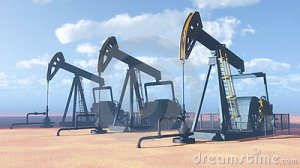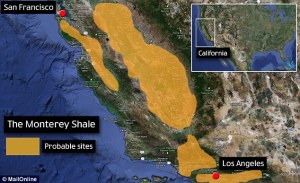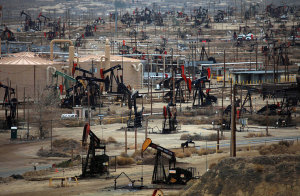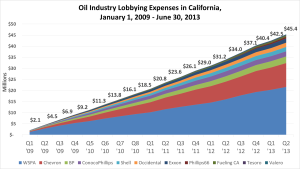 California is leading the rest of the nation in its push for using renewable energy, driving electric cars and installing solar panels.
California is leading the rest of the nation in its push for using renewable energy, driving electric cars and installing solar panels.
But its next economic growth will most likely come from the industry known for its old-fashioned derricks sucking the crude oil out of the ground.
As Golden State is doing some soul-searching figuring out how to raise the budget and create news jobs, the oil industry is willing to fill the gap.
In recent years, new technologies developed a method called fracking, which involves blasting a mixture of water, sand and chemicals into the underground to reach previously unaccessible oil and gas shales.
The method revolutionized the way the oil is extracted allowing petroleum companies multiply their production and give a start to the unprecedented economic growth.
Since 2008, fracking boosted the oil production by 80 percent, increasing its daily amount to 11 million barrels, supplying more oil and gas than Iran, Nigeria and Kuwait combined.
Last year, for the first time in two decades, the U.S. oil export exceeded the import, challenging the world’s petroleum giants such as Saudi Arabia and Qatar.
RT the good news: For the 1st time in nearly two decades, we're importing less oil than we're producing. pic.twitter.com/M30ewhgKqi
— White House Archived (@ObamaWhiteHouse) November 14, 2013
In June, the prices on domestic oil declined to $82.60 a barrel from $115.71 marking the lowest benchmark over the last four years, according to AAA Automotive Research Center.
In the meantime, the production in California, the fourth biggest world’s consumer of oil and gas, has been on the rise.
Last year, the oil production increased by 7 percent to 199.6 million barrels a year, making it the highest hike in 25 years, according to the state Department of Conservation’s Division of Oil, Gas and Geothermal Resources.
There are several large oil deposits in California that, experts forecast, will fuel next shale boom.
The Kern River Oilfield stretches underneath the San Joaquin Valley near Bakersfield and, by some estimates, contains around 476 million barrels of oil in reserve.
Another oil deposit located near Kern River is called Monterey Shale that occupies an area of 1,752 square miles. Until this year, it was considered the largest Californian oilfield.
 But recent reports filed by the federal officials revealed the shale contains only a tiny fraction of the expected amount.
But recent reports filed by the federal officials revealed the shale contains only a tiny fraction of the expected amount.
Still, even by the least optimistic estimates, the deposit has 600 million of recoverable crude oil, a number large enough to keep derricks drilling within the Californian border.
While the industry keeps pumping, it fuels the state and local economy in the form of taxes and jobs.
In 2012, the oil companies contributed $21.6 billion in state and local tax revenue and $15 billion in federal taxes, according to a report from the Los Angeles County Economic Development Corporation.
During the same year, the oil drillers added $18.7 billion in sales and excise taxes and contributed $113 billion in value added, which is 5.4 percent of the state GDP.
In the past seven years, the industry added 162,000 job openings to the market, which is 16,2 percent of all newly created jobs in California, according to the U.S. Bureau of Labor Statistics.
In 2012, The Kern County’s alone employed 47,706 people.
Just recently, IHS reported the petroleum industry plans to contribute five million new jobs nationwide over the next 10 years.
Meanwhile, the oil industry has been gaining new proponents among policy makers.
Gov. Jerry Brown, known for his support of the renewable energy, has recently cheered for the oil drilling.
“The fossil fuel deposits in California are incredible, the potential is extraordinary,” Gov. Brown said during a renewable energy conference in Goleta. “We want to get the greenhouse gas emissions down, but we also want to keep our economy going.”
Mark Nechodom, director of Department of Conservation’s Division of Oil, Gas and Geothermal Resources and the petroleum industry’s major regulator, echoed Brown’s words in his speech at the Modesto Area Partners in Science Conference.
“It’s hard to imagine how we would rapidly reduce our use of oil without a serious distraction of the economy, your well being and quality of life,” Nechodom said.
Colin Maynard, a spokesman for the Western States Petroleum Association, the organization that spent $20 million since 2009 lobbying state legislators, said the industry’s operations are the state economy’s integral part.
“[The oil industry] provides a product that really improves life of every citizen in the region,” Maynard said.
As the state submerges in the third year of the severe drought, many environmental groups raise concerns over oil operations that they say put under risk groundwater and other aquifers.
Some believe if the oil drilling continues to operate at the current scale, there might be long-term consequences.
“Jobs are important and there are other ways to get jobs,” Kathryn Phillips, director of the Sierra Club in Sacramento, said. “And public health is important and sustainability of environment is important. We need a functioning plant and an eco system to be able to have a strong economy.”
Phillips says in order to address environmental issues, the state needs “to keep the oil in the ground.”
“If we don’t address the climate change we’re not going to be worrying whether we have energy for moving our vehicles,” Phillips said. “We’re going to be wondering if we’re going to be able to survive.”
Besides the lasting environmental damage the state will likely have to deal with, the fall of the oil price might discourage the businesses from investing in alternative energy. With the current price of $3.01 per gallon, it might simply be costly to install solar panels and purchase electric cars in the future than rely on the cheap energy coming from the same old oil derricks.


Leave a Reply
You must be logged in to post a comment.